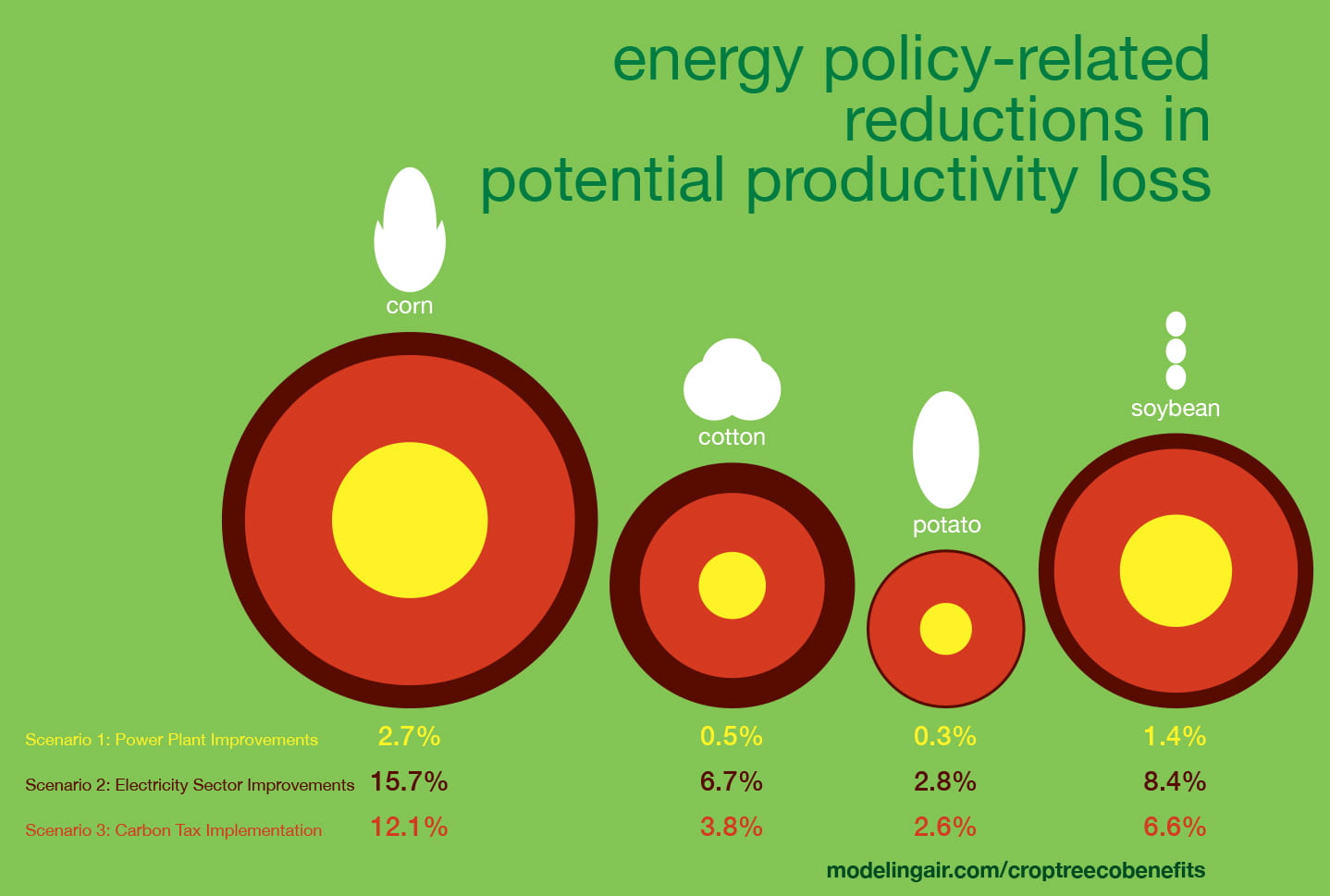People Aren't The Only Beneficiaries of Power Plant Carbon Standards

- Drexel Selects New, World-Class Life Sciences Building at 3201 Cuthbert Street for Medical Research Operations
- Breakthrough on Gene Therapy for Hereditary Spastic Paraplegia
- Drexel Environmental Collaboratory Releases Cross-Sector Findings on Severe Weather Recovery Challenges
- Drexel Launches the Manuel Stamatakis Center for Alternative Investments at the LeBow College of Business

Researchers projected the benefits of several carbon emissions standards on the productivity levels of key crop and tree species.
When the Environmental Protection Agency finalized the Clean Power Plan in 2015 it exercised its authority to regulate carbon dioxide emissions to protect public welfare. The Plan, now the focus of escalating debate, also put the nation on course to meet its goals under the Paris Climate Agreement. Given that other pollutants are emitted from power plants—along with carbon dioxide—research has shown that carbon emission standards for the power sector benefit human health. New research released today shows that they would also benefit crops and trees.
The study, “Estimating Potential Productivity Co-Benefits For Crops and Trees From Reduced Ozone With U.S. Coal Power Plan Carbon Standards,” was recently published in the Journal of Geophysical Research Atmospheres and authored by researchers from Drexel University, Syracuse University, Boston University, and Harvard University, convened by the Science Policy Exchange. It is the first study to model the ecosystem impact of contrasting policies, one of which was similar to the Clean Power Plan.
“In assessing the regulatory impact of the Clean Power Plan the EPA estimated monetary benefits of reduced carbon-dioxide emissions, as well as quantifying and monetizing certain public health benefits, such as reduction in premature mortality and morbidity due to particulate matter or ozone exposure,” the researchers write. “The EPA did not quantify the co-benefits to crops and trees but treated these co-benefits qualitatively.”
According to the study, which included an option similar to the Clean Power Plan, the corresponding reduction in carbon, nitrogen and sulfur emissions from coal power plants would also mean a decrease in ground-level ozone—a known inhibitor of plant growth. And by modeling these reductions in the year 2020, the researchers found that they would provide a significant boost to the productivity of key indicator crops, such as corn, cotton, soybean and potato; as well as several tree species.
“Our findings suggest that crops like corn, soybeans and cotton could benefit from substantial productivity gains under moderate carbon standards for power plants,” said Shannon Capps, PhD, an assistant professor in Drexel’s College of Engineering and an author of the study. “With policies similar to those in the Clean Power Plan, we’re projecting more than a 15 percent reduction in corn productivity losses due to ozone exposure, compared to business as usual, and about half of that for cotton and soybeans. Depending on market value fluctuations of these crops over the next few years, that could mean gains of tens of millions of dollars for farmers—especially in areas like the Ohio River Valley where power plants currently contribute to ground-level ozone.”
The team used three policy scenarios that encompass a range of emissions targets and reductions measures, and they compared each policy scenario with a “business-as-usual” reference case that represents current clean air policies, as well as energy demand and market projections.
Then, using a computer model widely employed to help guide state-level decision making for compliance with the National Ambient Air Quality Standards, the group generated a detailed projection of what the surface-layer ozone would look like across the country under each policy scenario through 2020.
The team looked at the consequences of lower ozone for five crops whose primary growing season is June through August, which is the period when ground-level ozone is known to be at its peak. They also evaluated the consequences for 11 tree species, including eastern cottonwood, black cherry, quaking aspen and several species of pine. These crops and trees have been used as standard indicators in environmental research. Based on previous research by crop and tree scientists, the team could relate their models’ ozone-exposure findings to the productivity of crop and tree species.
“The option most similar to the Clean Power Plan has the greatest estimated productivity gains for the crops and trees that we studied,” said Capps. “The improvement in crop yield and tree growth was strongly tied to the level of carbon dioxide emissions reductions and adoption of cleaner energy achieved by the policy.”
Under the business-as-usual scenario, the productivity of soybean, potatoes, and cotton is reduced about 1.5 percent, with only slight impacts on corn. These levels of production only slightly improve under a policy scenario that includes only “inside the fenceline measures” such as improving the efficiency of coal-fired power plants.
A second scenario, that most closely resembles the Clean Power Plan and includes demand-side energy efficiency, substituting lower-emitting natural gas plants and zero-emitting solar and wind power into the energy mix—produces larger results. The potential corn production lost to ozone exposure in the reference scenario is reduced by 15.7 percent, soybean losses are reduced by 8.4 percent and cotton losses are diminished by 6.7 percent.
Under the third scenario, which reflects putting a price on carbon, and achieves similar emissions reductions as the second scenario, the researchers project slightly lower reductions in ozone-induced losses for corn (12.1 percent), soybean (6.6 percent) and cotton (3.8 percent).
Productivity among tree species, as measured in biomass yield compared to the reference scenario, also suggests that the plants will benefit from ozone-reducing policies. The tree species with the greatest potential for productivity losses, black cherry and eastern cottonwood, show 7.6 and 8.4 percent reductions in the projected ozone-induced biomass reductions, respectively, under the scenario most like the Clean Power Plan.

“Our work shows the importance of considering the co-benefits of our nation’s energy policies going forward,” said Charles Driscoll, PhD, professor at Syracuse University and co-author of the study. “These benefits to people and plants are nearly immediate and occur in urban and rural communities across the U.S. We know from this and other studies that the economic value of the added benefits from power plant carbon standards are large and exceed the estimated cost of implementation.”
Members of the team are also analyzing the co-benefits of power plant carbon standards for reducing regional haze and acid rain and conducting new research on the co-benefits of the final clean power plan as compared to different energy policy futures.
Results of the study are accessible at: http://modelingair.com/croptreecobenefits.
Drexel News is produced by
University Marketing and Communications.